Last month, another of Lombardi’s Packers passed away–left tackle Bob Skoronski. I have written about this Pro Bowl stalwart previously here, but wanted to make a couple more points in tribute.
First, Skoronski figured prominently in two of my favorite plays from that championship time. In the November 8, 1964 game against the Lions, Jim Taylor broke off the longest run of the whole era. He took a quick toss to the right from Bart Starr, followed point-of-attack blocks by Ron Kramer on the defensive end, Paul Hornung on the linebacker and Forrest Gregg on a defensive back to break free and score on an 84-yard run. It’s still the third longest run in team history. What has always been particularly striking to me, though, is the final block by Bob Skoronski. Left tackle Skoronski hustles all the way across the field to make his block 80 yards downfield, clearing away Dick LeBeau so that Taylor can reach paydirt.
Skoronski said at the time: “LeBeau kept backing up on me. I just ran him back. I could feel Jim on my tail, and I knew we were gaining another yard every time LeBeau backed up so that was fine with me. If he’d planted his feet, I would have taken him out – I was kind of hoping he would as a matter of fact.”
Skoronski also made the crucial seal block on George Andrie that allowed Chuck Mercein to slip free to the Cowboy three on a trap play at the conclusion of the Ice Bowl. Skoronski’s comment on that game is my second tribute. He called the game “Our mark of distinction,” and that phrase from the team captain perfectly summarized the greatest moment in team history.
Steady, hustling leadership was his mark of distinction. RIP Bob Skoronski.




Tall Boy and TV set custom cards are colorized.


























































